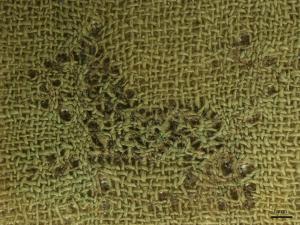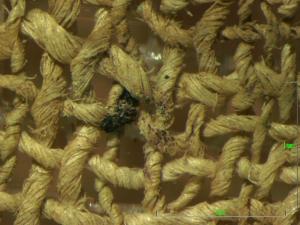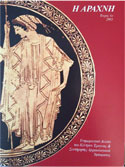Koropi
The find consists of three different fabrics that have been discovered together in 1954 in a 5th century BC funerary context in Koropi, East Attica. They have been deposited inside a bronze kalpis, in contact with the bones of the deceased. The kalpis has been sold privately and the fabrics are now in the Victoria and Albert Museum, London.
The fabrics from Koropi represent another testimony to exceptional ancient textiles. They combine most of the technical characteristics and decorative techniques encountered in the Classical period: embroidery, use of metal threads, hard-twisted threads, painting, decoration with additional coloured weft, decoration created with floating threads and preserved lateral edge with a coloured band.
Fabric 1
The first fabric is a linen balanced tabby preserved in two fragments. This fabric constitutes the first embroidery discovered in Greece, representing a diaper pattern with each lozenge containing a walking lion. All lions are looking in the same direction in each fragment; in the first one, they are looking to the right and vice versa. The size of the lions is very small, with length less than a centimetre. According to J. Beckwith who studied the fabric, the embroidery has been created using gilded silver threads, as attested by traces of metallic salts and organic remains of the embroidery thread.
Fabric 2
The second fabric is conserved in three fragments of different dimensions. This linen balanced tabby is decorated with painted lozenges. In some areas of the textile the threads are covered with dark dyestuffs that have remained on the surface and not penetrated inside the fibres. It seems that a reddish pattern was painted inside the lozenges as well. There is no information about the nature of the dyestuff, as no analyses have been conducted yet.
This fabric also preserves traces of two different decoration techniques created during weaving. Firstly, black threads are inserted in the cloth, not associated to embroidery, but rather to a decorative supplementary weft. Secondly, traces of a decoration created by floating weft and warp threads can be observed in certain parts of the fabric. As sometimes these patterns cover an area of several centimetres, they seem to have been created deliberately and not by a weaving mistake. The threads have a waved appearance and the twist is often very high.
Fabric 3
The fabric is preserved in one fragment. It is a balanced linen tabby with very bright and shiny threads, which probably indicates that the fibres had been carefully processed before spinning. A lateral edge is preserved in 33 cm, showing a densely woven reinforced area created by seven warp threads. Several traces of a black thread inserted in the cloth have been identified near the edge. It does not seem to be an embroidery thread, but rather an additional weft, used to create a decoration during weaving. The nature of the dyestuff has not been analysed yet.
Publications:
Beckwith J. 1954 Textile Fragments from Classical Antiquity: an important find at Koropi near Athens, Illustrated London News 224, 114-115.
Spantidaki Y. and Moulhérat C. 2012 Greece. In M. Gleba and U. Mannering (eds.) Textiles and Textile Production in Europe: From Prehistory to AD 400. Oxford, Oxbow Books, Ancient Textiles Series 11.
Spantidaki S. 2016 Textile Production in Classical Athens. Oxford, Oxbow Books, Ancient Textiles Series 27.
- Log in to post comments





